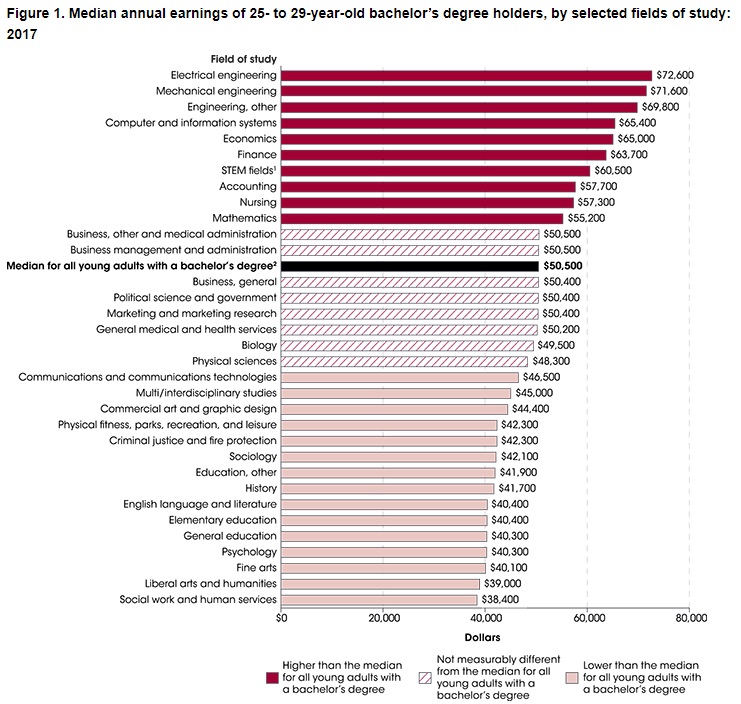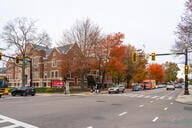You have /5 articles left.
Sign up for a free account or log in.

Istockphoto.com/Attankun Thongbun
The federal government on Wednesday released a wide range of updated and new data on postsecondary education, including broader measures of college completion and several indicators that show how much family wealth contributes to college students’ odds of enrolling and graduating.
For example, among people who were ninth graders a decade ago, those from the highest quintile of socioeconomic status (parental education and occupations and family income) were 50 percentage points more likely to be enrolled in college in 2016 than were their peers from the lowest quintile -- 78 percent compared to 28 percent.
Money also played a big role in which college and level of degree program students enrolled in, according to the new report from the U.S. Department of Education’s National Center for Education Statistics (NCES).
Students from the lowest quintile who attended college were more likely to first pursue an associate degree (42 percent) than a bachelor’s degree (32 percent). Their peers from the wealthiest quintile, however, were much more likely to first seek a four-year degree (78 percent) than a two-year degree (13 percent).
Likewise, the percentage of higher-income students who first enrolled at a highly selective college or university (37 percent) easily outpaced that of lower-income students (7 percent).
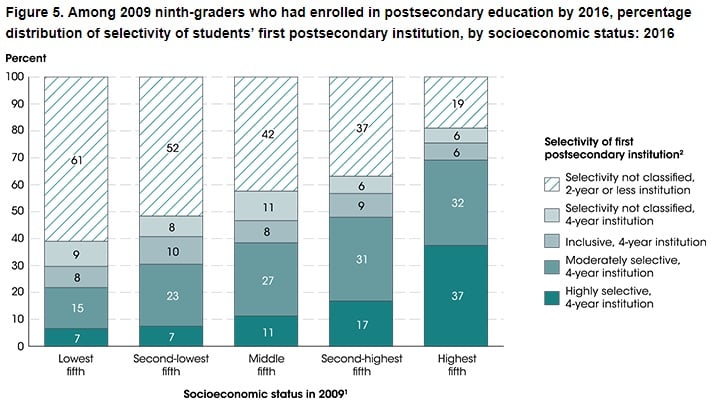
Wealthier students also were much more likely to enroll at a four-year college than at a community college or for-profit institution. More than half of students from the top quintile first enrolled at a public four-year institution (54 percent), while 26 percent enrolled at a four-year private college. The report found that 18 percent enrolled at a community college while less than 2 percent attended a for-profit.
Among students in the lowest quintile, however, 51 percent first enrolled at a community college (or program length of shorter than two years) compared to 28 percent at a four-year public, 8 percent at a four-year private and roughly 13 percent at a for-profit.
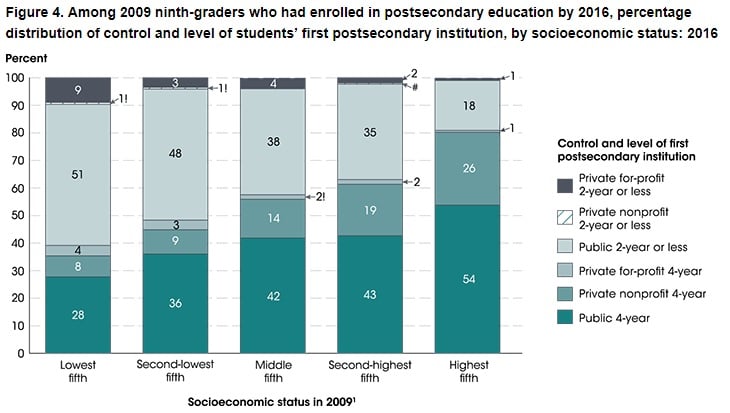
The report found that lower-income students from that ninth-grade Class of 2009 were less likely to enroll in college within one year of graduating from high school.
Roughly one-third of students from the lowest quintile of that cohort enrolled within one year of graduating high school and were still in college or had earned a credential by 2016, according to the report, compared to 79 percent of students from the top quintile. Likewise, 53 percent of students from the lowest quintile either never enrolled or delayed their enrollment by more than a year, compared to roughly 11 percent from the top quintile -- 88 percent from this group enrolled in college within one year after high school.
“These numbers are sobering,” said Amanda Bergson-Shilcock, director of upskilling policy at the National Skills Coalition, who called the new report an “affirmation of how diverse the higher education cohort is, and how different the college-going experience can be.”
Completion Rates for Part-Time Students
The new data arrived as the higher education sector has been rocked by scrutiny of its role in perpetuating economic inequality, thanks to a high-profile admissions scandal and unflattering data on social mobility.
As with the Varsity Blues scandal, the federal numbers pull back the curtain on how higher education is stacked in favor of white and wealthy students, said Phil Martin, a spokesman for the Education Trust.
"Students from the least affluent families who enrolled in college were more than three times as likely to start at a community college than their wealthier peers. Community colleges are starved for resources. No surprise their outcomes aren't great," Martin said via email. "Students from the most affluent families were about five times as likely to enroll in a selective college as students from the least affluent families. Selective colleges are typically the ones with lots of resources. So the wealthiest students get the richest campus experience."
The Education Department's annually released report, dubbed "The Condition of Education 2019," features updated and improved measures of student success. Some of those indicators can be broken out by the relative wealth and race and other characteristics of students, including whether they attended college full-time or part-time.
As was the case with students’ enrollment patterns, socioeconomic status had a big impact on those outcomes, according to the data.
For example, the report includes updated completion rates for Pell Grant recipients (data that did not become available until the department recently broadened its completion metrics). The federal grants are need based and represent a subset of lower-income students within the general undergraduate population, the report said.
Completion rates after eight years for the 2009 cohort were lower for Pell recipients who attended four-year colleges across all levels of selectivity except for open-admissions institutions.
For colleges that accepted 90 percent or more of applicants, the new federal completion rates were about 12 percentage points lower for Pell recipients than for nonrecipients (35 percent compared to 47 percent). Among colleges that accepted less than a quarter of applicants, completion rates for Pell recipients lagged by 10 percentage points (79 percent compared to 89 percent).
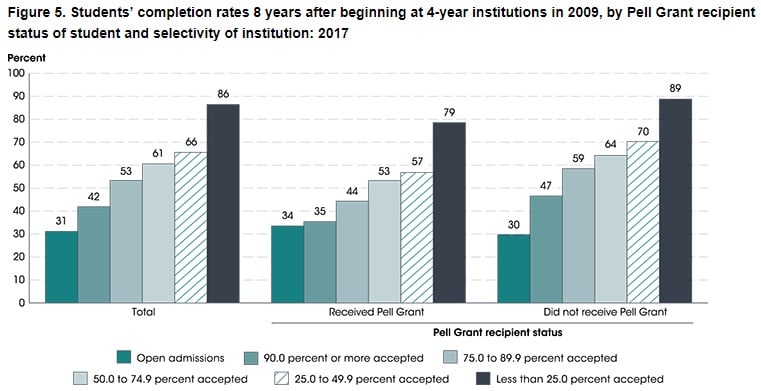
NCES recently began publishing college completion rates that include part-time students, an improvement from the much-criticized previous limitation of only tracking graduation and transfer rates for full-time students who attend college for the first time.
“This provides the clearest picture yet of how colleges are doing in providing all of their students a credential,” said Michael Itzkowitz, president of the Edvisors Group, a consulting firm, and a former Education Department official during the Obama administration. “This is much more representative of all students who are attending college today.”
For example, the report said just 22 percent of students attended public colleges on a full-time, first-time basis, compared to 42 percent who attended part-time and had previously enrolled at another postsecondary institution.
Yet the addition of part-time students to colleges' completion report card doesn’t make them look better.
The full-time, first-time rate was the “most generous” measure, Itzkowitz said. The new report found that most institutions have eight-year graduation rates of less than 50 percent, he said, although those numbers improve substantially when transfer numbers are added.
“The typical institution leaves students with a mere 50-50 chance of graduating from the institution where they started,” he said, adding that a high percentage of part-time students are “leaving without any credential in hand.”
The “nontraditional” student is the norm for the two-year sector, with three-quarters of the 4.7 million community college students who enrolled in 2009 attending either part-time or not for the first time, meaning they were not included in traditional graduation and retention rates.
Graduation rates for students who enrolled at a community college in 2009 were higher among those who attended full-time (30 percent of first-time students and 38 percent of non-first-time students earned a credential at that college within eight years) than for part-time students (16 percent for first-time students and 21 percent for their non-first-time peers).
Transfer rates for community college students eight years after entry were higher among students who had previously enrolled elsewhere (37 percent for part-time students and 30 percent for full-time students) than among their first-time peers (24 percent for both full-time and part-time).
Part-time students also make up large shares of enrollments at four-year institutions. The report found that 44 percent of students who enrolled at a four-year public in 2009 attended full-time and first time, as did 57 percent of students at four-year privates.
Part-time students at four-year colleges were unlikely to graduate within eight years. Just 19 percent of part-time, first-time students who enrolled at a four-year public or private graduated within eight years, according to the report, compared to 32 percent of part-time students at publics who previously attended another institution and 43 percent at privates. (In most cases, similar portions of those students transferred to another college.)
The report should be a call to action for policy makers, said Martin.
"Students from low-income families are underserved at every level of the U.S. education system," he said. "That's obviously not the kind of system anybody would set up if the goal was equal opportunity."
New Data on Wages
The federal data also included updated employment outcomes for bachelor’s degree holders.
Unemployment rates for young adults (ages 25-29) with a bachelor’s degree were lower in 2017 than in 2010, when the recession was in full swing (3.1 percent compared to 5.6 percent). But median annual earnings (inflation adjusted) were not measurably different.
The median annual earnings for young adults with a bachelor’s degree were $50,500, according to the report, which included both wages and unemployment rates by selected fields of study.
Earnings ranged from $38,400 for graduates with degrees in social work and human services ($39,000 for those with degrees in liberal arts and humanities) to slightly more than $70,000 for holders of bachelor’s degrees in electrical and mechanical engineering.
Graduates with liberal arts and humanities degrees had an unemployment rate of 5.8 percent, which was the highest among fields covered by the data.
